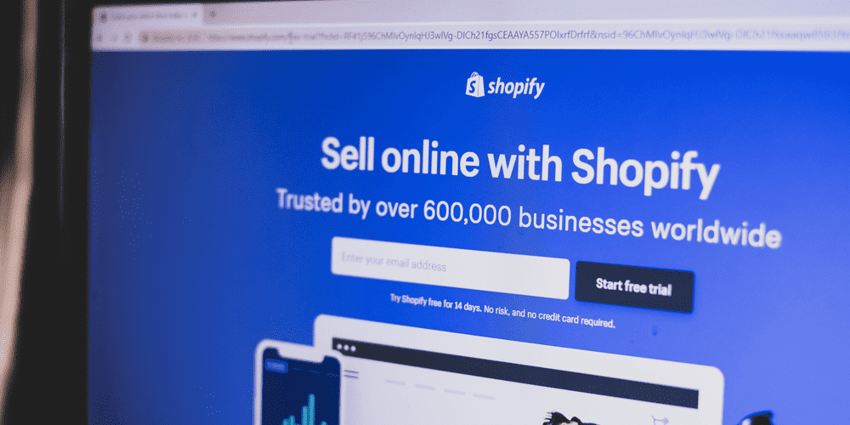What is Shopify?
Many have heard of Shopify, but few know the answers to the questions, what is Shopify and why was it built. Shopify is a SaaS (software as a service) shopping cart solution that you can subscribe to in order to manage both digital and physical sales. Simply put - Shopify is an ecommerce platform that lets you sell (almost) any item online. In fact, Shopify was built with the average seller, who may not be tech-savvy, in mind. This means that they've deliberately made it so shop owners don't have to fiddle and fuss with tech in order to build their website from scratch. These are some of the benefits of selling on Shopify:
- You don't need to know a single line of web code, which is great for beginners
- Designing your online store is easy, there are a ton of existing themes that you can choose from
- You can choose a custom domain name and host it on Shopify
- Shopify has a lot of native tools for you to manage and track your orders and payments. Almost everything you need to run a store successfully is already caked into the platform.
Selling on Shopify: Where to start?
The best thing about Shopify is it's easy and straightforward set up. If you've got 20 mins to spare and a product to sell, you could potentially start making money today. Here's your checklist to getting started on Shopify:
- Sign-up, and create an account
- Name your store
- Add a business address
- Customise your storefront
- Add your first product
- Create a custom domain for your store
Most of the steps from 1-3 are fairly straightforward, and act like any other sign-up process. If you haven't thought of a name for your store yet, weh ave some great tips in our How to Start Selling on Etsy guide. The bulk of the work rests with steps 4-6, so we'll start your Shopify store there.
Creating your online store
The first step is to sign up (of course). You'll be prompted to enter a valid email, a password and a store name. Your store name will be how potential customers will find your business and will make up part of your store's URL. Once your Shopify account has been created, you will be asked to enter your name, business address, phone number and what you are selling. You'll then be directed to the Shopify admin panel so you can start the process of setting up your store.
Adding your products
From the products page of your Shopify admin panel, you can start to add products to sell in your online store. If you've got your products in a CSV file, you can import them easily into your Shopify catalog through the bulk upload function. You will be prompted to add the name of the product, a product description, price and product images. And if relevant product variations (color, size) and SKU codes. You can then collate similar products under one category. When uploading your products, you need to consider three important characteristics to create a high-converting page:
- Product photography
- Product descriptions
- Product reviews
Customising your online store
The look and experience of your online storefront matters as much as its functionality. In fact, 38% of people will leave a website if they find the layout to be unattractive. Your product visuals in particular, will help (or dissuade) a potential customer from purchasing your product. It's important to remember that customer attention spans are shortening, you have 15 milliseconds to grab someone's attention, and you'll need to select the best template for your business to do so.
What other eCommerce features are necessary for your store to run smoothly? We've polled our customers, and these are the eight necessary features they chose for their website
When picking a template, here are a few things you need to consider:
- High quality visuals
- Areas that showcase your stores new arrivals or promotions
- Mobile optimised design
- User-friendly design
- Easy checkout, with payment options
Some tried and tested Shopify themes include:
How much does it cost to sell on Shopify?
Before you decide if Shopify is the right platform for your business, you need to know what each pricing package offers. There are three main pricing plans to choose from:
- Shopify Basic costs $29 per month, with 2.9% 30c per online transaction
- Shopify costs $79 per month, with 2.6% 30c per transaction
- Advanced Shopify costs $299 per month, with 2.4% 30c per transaction
In addition to the three main pricing plans, there are two additional "plans" that you can adopt.
- Shopify Plus - Starting at $2000 per month, Shopify Plus is a more comprehensive solution for customers that are large and experiencing high-growth. They may not have the technical experience to run a platform of that size, and so a team is dedicated to assist.
- Shopify Lite - At a low price of $9 per month, and a transaction fee of 2%, this add-on is for sellers who have already got a functional website, but want to take advantage of some Shopify features. You can integrate your Squarespace, Magento or Wix websites with this plan in order to get access to features like shopping cart functionality or social media advertising (ex. Facebook messenger selling).
What are the best products to sell on Shopify?
Finding products to sell on Shopify can be pretty daunting.
Everyone knows the age-old AliExpress trick to bootstrapping your store. But, there are hundreds of products to choose from. How do you know which ones are winning products in the long-run? Well, there are five keys to a great product:
- Profit margins
- Price point
- Size/weight
- Popularity
- Competitiveness
Profitability
The first question you should ask yourself when selecting a product for your store is, is it profitable?
You should always aim for at least a 10-15% profit margin on products to cover your expenses. Lots of sellers jump into selling online by picking products that they love, not realizing that expenses tend to stack up fast in this line of business. There's the processing fees, the fees to open your store, any marketing fees (because inevitably you'll be running ads on Facebook or AdWords in order to word out there about your store) and of course packaging and shipping.
Part of this internal discussion with yourself, is to think about your entire catalog and how bundling, upselling and offering volume discounts on products can increase your AOV (average order value). Increasing your AOV correlates to an increase in profit, and offsets any acquisition costs you had to spend to get them on your website.
Price point
Your price point and profitability work in tandem to make your store more "sellable". The larger-ticket your item is, the harder you'll have to work to earn your customer's trust. Think about it. When you're purchasing a car, you'll spend months looking around, comparing models, but if you're purchasing a $20 shirt, you're more likely to make that purchase on the spot. Anything above the $100 range, you're starting to get into iffy territory. Your customers will want extra information to validate their purchasing decision. This could come in the form of customer reviews or multimedia content.
Size and weight
Ideally, you should be selling products that are light and don't take up a lot of space. This makes shipping more cost-effective and in turn, allows you to offer free shipping to your customers. In fact, 93% of online buyers are encouraged to buy more products if free shipping options are available.
Popularity
Any product that you sell should be popular and in-demand. How do you know if something's popular? There are a few tricks you can use to determine this:
- Amazon best sellers
- Etsy's best sellers
- Trendhunter
- eBay's best sellers
Once you pick a product, run them through Google Trends to generate a report of search volume for the last year or more. Some of these items include:
- Baby carriers
- Smartwatches
- Shapewear
- Petcare
- Reusable packaging
Competitiveness
Now that you've picked your a couple of products, you want to make sure that you're not selling the same products that customers can purchase from a bunch of other retailers. You eventually risk getting into a price race to the bottom. To make sure that you're not faced with a lot of competition in the market, simply Google your product and see how many businesses come up, what their reviews are like and if you can find any unique features for your store. It's important to note that a unique proposition doesn't matter so much, as long as you have a solid distribution/marketing plan for your store.
How to organise your shipping?
If your intent is to sell physical items through an online Shopify storefront, then you'll need to set up a delivery service to complete your customer experience.
Although Shopify can calculate shipping rates in their in-built suite, the delivery costs often work out to be much higher than using a third-party plugin or app through their app store. Interparcel's Shipping Manager can be integrated with Shopify stores, so that you can import orders and get access to the biggest range of courier services in Australia and the best custom pricing deals in a matter of seconds. By connecting your Shopify and Interparcel accounts you can process online orders quickly and all the appropriate labels and forms for your parcels are electronically mailed to you.
Consider integrating your store with Facebook Shops
Just a few days ago, Facebook shops was announced during a live event featuring Tobi Lutke, CEO of Shopify, and Mark Zuckerberg, CEO of Facebook. Facebook Shops allows Shopify sellers to control customization and merchandising for their storefronts on Facebook and Instagram while using Shopify to manage their inventory, orders and fulfilment. Simplistically, Facebook Shops is an extension or an add-on to Shopify stores. The benefits are mostly for small businesses:
- Your community stays on Facebook with the added ability to check-out natively, making monetizing your page and expanding your audience easier.
- Added engagement and loyalty tools like coupons and discount codes for your Facebook community.
- Integration with WhatsApp and Messenger, provides a direct line of communication with potential customers, which you would otherwise need a third-party for.
Check out our guide on how to sell on Facebook Marketplace to expand your stores reach.
Use Shopify to optimise your eBay and Amazon stores
If you're already selling successfully on eBay and you want to increase your sale strategy, you can integrate your account with Shopify.
- You'll need to already have a sellers account on eBay to connect with Shopify, so make sure this is already set up. You can use our guide on how to sell on eBay to walk you through this process.
- Add all the items you would like to sell on eBay to your Shopify account. After doing so, you can sync your product descriptions straight from your eBay sales channel.
- By integrating eBay and SHopify this way you can manage your account through Shopify, whilst using eBay's handy messaging service to stay in touch with customers.
Frequently asked questions
What does the Interparcel Shopify App do?
The Interparcel Shipping Manager is free for everyone. It enables you to offer multi carrier live quoting on your checkout page. Reduce card abadndonment by offering both standard and express shipping options. Connecting your Shopify store to the Interparcel Shipping Manager will allow you to import your orders with a click of a button and despatch your orders fast.
How long will it take for my Shopify store to start making money?
It depends on a variety of factors. Every store is different, and will therefore take a different amount of time to start bringing in revenue. It ultimately boils down to your product, how you've set up your store and the amount that you're spending on ads to bring in traffic.
How do I find out what theme a store is using?
If you're browsing eCommerce websites and come across a Shopify store that you like the look of, there's an easy way to find out which theme they're using. Go to the website, and open up the developer tools and search for "theme".
How do I sell digital products on Shopify?
When most people think of Shopify, they think of selling physical products. But you can sell videos, ebooks, audio tracks, software and photography. You can use the Digital Downloads app that was built by Shopify to integrate with your store and make use of bundled packages where relevant.
Is it better to sell on Amazon or Shopify?
When it comes to selling things online, both Amazon and Shopify do the same thing. The difference between Shopify and Amazon is their suite of tools that they provide to online sellers, like blogging, integration with Facebook, social media integration and email marketing. The downside to Shopify is that it'll take you longer to set up if you want all the bells and whistles.










 Facebook
Facebook Twitter
Twitter Instagram
Instagram Linked In
Linked In YouTube
YouTube